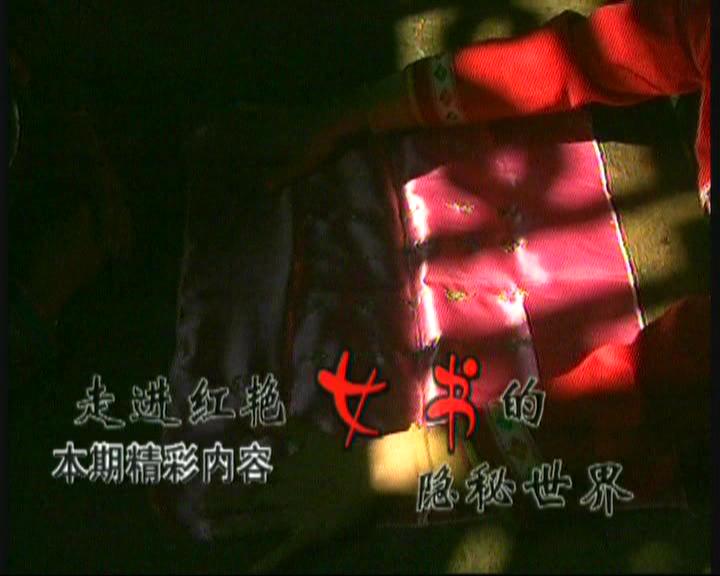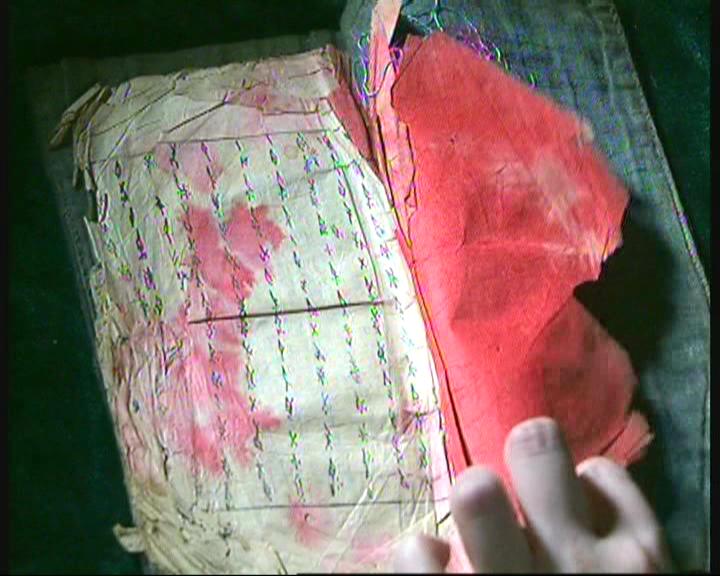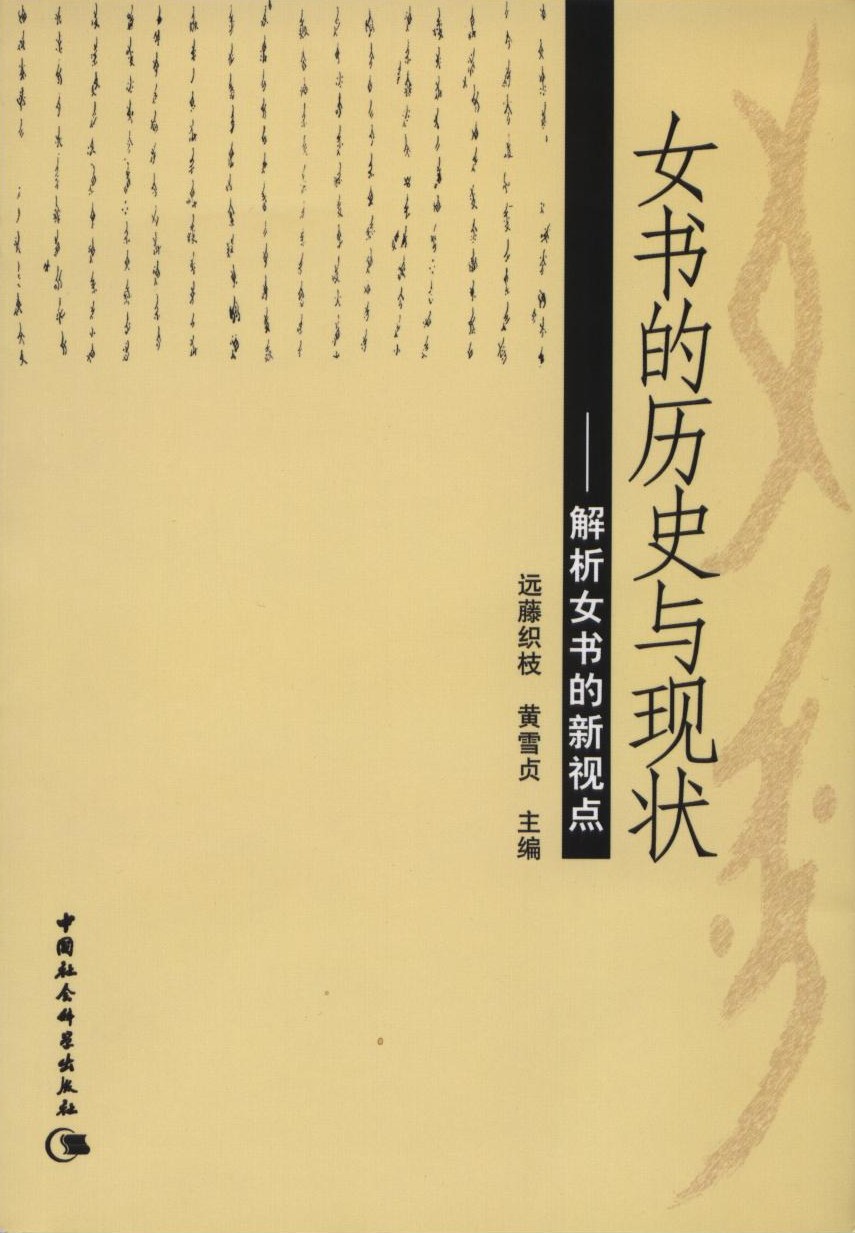During June and July 2005, Ms.Ding Yuhua(丁育華), a graduate student of the University of Tokushima, conducted field research about Nushu in compliance with my request. She interviewed four local persons( A and B) according to the questionnaires prepared by me.
I would like to comment on these answers as follows:
I believe that some more valuable original materials are still left. When I went to the village for survey some years ago, I saw several copies of SanChao Shu [(三朝書) (third day missives) ] there. If the provincial government makes a strenuous effort to search all the villages for remaining Nushu materials, they ought to be able to find and collect some more, and unless they take quick action, such materials may be scattered and lost. Whenever I visited the village, I appealed to them on this matter, but they have been slow to proceed with a steady search.
I am not sure what planning for Nushu village is, but do they intend to enrich the Nushu cultural village built inPu Mei Cun (晋美村) in 2001?The village was built for tourism, but when I visited there in 2004, I found few visitors and it looked like it was declining.
So I do not think that the project to build such an institution, spending a large amount of money, has been successful for preserving and protecting Nushu.
What He Yanxin (何艶新) said worries me. I fear that if she continues to be busy taking care of her grandchildren and has no time to write Nushu, she might forget it in spite of having restored it with much effort. If her habit of frequently writing Nushu is discontinued, her attachment to the script would be lessened soon and her appetite for writing her mind would not be inspired. I cannot but wish that the government would allow He Yanxin (何艶新) some living expenses and her traditional style of writing Nushu will be preserved for a long time.
Ⅱ. TV broadcasting about Nushu

On February 26, 2006, a program titled "走進紅艶‘女書'的隠秘世界" was televised on channel 3 by Bejing TV station for 45 minutes from 18:55, where I was on too. The program is one of the series programs called "印象中国伝奇", that is broadcasted every Sunday evening.
Its outline is as follows:
They reported and commented on many sides such as the present picture of the villagers where Nushu had been transmitted, how local women were living, the fact of sworn sisters in the old days, the number of Nushu characters, its history and future. etc.
When I visited Beijing last autumn, I was interviewed by the TV station as one of the researchers of Nushu such as Zhao Liming (趙麗明). In the program I talked on the attraction of the script, its history and the object of study as follows:
First, the attraction of Nushu: I was very surprised to see the script at first as if an electric shock went through me. I found the Nushu characters to bevery delicate, neat and beautiful, and since then I have been fascinated by the script.
Zhou Shuoyi (周碩沂) spoke about the history of Nushu: "I collected about 500 to 600 kinds of Nushu characters and found that the Chinese numerals about 3,000 to 5,000 years ago resemble those of Nushu closely except for four. Therefore, I can say that Nushu has a history of 4,000 years at least."
In response to this view, Zhao Liming (趙麗明) commented: "It is worldly common phenomenon that numerals and characters correspond each other like 1 to 2, 2 to 2, etc. Therefore, even if there are numerals similar to inscriptions on bones and tortoise carapaces, we should not rely on it for the ground of our argument. I learned Nushu from Yang Huanyi (陽煥宜) and found that about 80% to 90% of the characters had been derived from Chinese characters. So, Nushu characters can be said to be basically different styles of Chinese characters."
Then I commented too: "I think Nushu comes from Chinese characters. Nushu characters look like simplified Chinese ones which were created in the era of the Sun dynasty. Therefore, it can be said as a conclusion that Nushu characters were born from the Sun dynasty onward at the earliest."
As for written materials, first San Chao Shu (三朝書) is closed up and the narrator tells: "Nushu is connected with women's suffering and worries. This was presented to a daughter to get married by her friend. In the booklet women's suffering and sorrow of parting were written a lot. Especially, when one sworn sister was going to get married, the other one wrote songs from heart-breaking to give them to her. Other than 三朝書, there are women's autobiographies, traditional songs and local histories."

Then followed my comment:"As a Japanese, I am particularly interested in the anti-Japanese songs. While I was conducting local research, I felt pained to find that the Japanese army had invaded the village in 1944. I feel very sorry for the people in the area. There are anti-Japanese songs written in Nushu that they sung during the war against Japan . The songs written by women in Nushu were transmitted. As they are not so old, I am trying to find more details about the circumstances when they were written and anyone who knows how they were concerned with Nushu.
The anti-Japanese songs in the village are different from those in other areas. General anti-Japanese songs were violent slogans such as "Down with the Japanese army!" and "Folks, get up!" expressing the people's anger. However, the songs in the area have no such severity. Based on the traditional form of the songs sung by the local women, they sang with emotion about how they had been attacked by bombers and suffered damage, how hard it was for them to live after their breadwinners had been taken by force, how they were suffering from high tax and so on.
The anti-Japanese songs in the village were based on the traditional form of writing songs in Nushu like making one line from seven words, words to start singing, expressions and so on, which is quite different from those written in other areas. As it is the character of traditional Nushu to complain of sorrow and pain, the anti-Japanese songs took over it to express local women's suffering and hardships that were caused by the war and the Japanese army. Therefore, they have an atmosphere completely different from general anti-Japanese songs which expressed people's anger straight.
The expression of sorrow and hardship in the form of Nushu songs were strong in appealing to people because they were familiar to them in feeling even without severity of language. They never shouted slogans, but by uttering grief feelingly and plainly, their feeling against Japan must have penetrated through people's mind deeply."
Regarding the fact that the local women wrote songs in Nushu and sang together looking at the characters, Zhao Liming (趙麗明) talked as follows:
"The role and function of Nushu was to complain of their pains in their autobiographies and to share present pains, misfortunes and worries with each other. One woman sang, appealing to her friends around her. As the audience had the same pains as her, they sympathized with her trying to share their pains with each other. Thus, Nushu songs had a function of psychological adjustment and an element of feminism. For example, since yellow was the emperor's color in old days, people were not allowed to use it, but Gao Yinxian (高銀仙) left songs written on a yellow silk handkerchief. The women were proud of having systematic original characters. They had a linguistic right to express their feelings in their works by their own characters." Thus, she appraised the function and value of the script highly.
In this program, the actual condition and significance of the script were carefully explained so that even the TV viewers who had no idea of the script could understand. A lot of things concerned were well arranged there. However, there was no presentation of the status quo and official policy of preserving the script by the local government, which was not satisfactory to me as I wanted to get the latest information. Then, on March 8, 2006, I made a phone interview with Ms. Liu Chun (陸春), a director of Beijing Broadcasting Station, who had called on me for an interview after broadcasting. The following are my questions and her answers:
I heard five years ago that the prefectural government had planned to do something for preservation by American aid, so I felt that was nothing new. As for a girl learning the script, what Ms. Ding (丁) saw should be pretty different from the actualities. That may be an example of a girl's cooperation with news gathering after receiving five yuans.
Most of the audience responses to the TV broadcasting seemed to be friendly, so it is considered that a certain appraisal of the broadcast was gained. The program was broadcasted for as long as 50 minutes in prime time. It had been prepared estimated that a program with such contents must be accepted by Chinese with interest. As a result, it must have played a fair role of introducing Nushu.
Ⅲ.Publication of "The History and Status Quo of Chinese Women's Script" (女書的歴史与現状)

The book was edited by Huang Xhuezhen (黄雪貞) and Orie Endo on the basis of the presentations made at the symposium titled "The History, Status Quo and Future of Nushu" (女書歴史・現在・未来), which had been held in Beijing in 2004 and published by 社会学出版社. The following are its contents:
- Preface. The women's script in the culture area of the Chinese character in Asia. Orie Endo
- Change in sound of music words of Nushu. Huang Xuezhen (高雪貞)
- Reconsideration of women's script and ancient racial characters, and study of the age of the script. Shi Jinbo (史金波)
- Shape, sound, meaning and origin of Nushu. Chen Qinguang (陳其光)
- The polysemy of syllabic letters characteristic of Nushu. Zhang Zhenxing (張振興)
- Some causes for the functional decline of Nushu. Chen Liwei (陳力衛)
- Study of Nushu from the linguistic point of view. Li Lan (李藍) and Zhao Liming (趙麗明)
- The scientific value of "comparison of Nushu vocabulary". Zhao Liming (趙麗明)
- The variant form of characters in the list of Nushu characters. Sun Qi (孫)
- A proposal as to compiling a dictionary of Nushu characters. Takashi Sakurai
- A problem on the currency with women's script of Taiping-tianguo (太平天国). Zhang Tiebao (張鉄宝)
- Anti-Japanese songs written in women's script. Orie Endou
- The melody of Nushu songs and the tone of the native tales of Chengjian (城間). LiuYing (劉頴)
- Consideration of study of Nushu. Huang Qingfa (黄慶法)
- Mystic designs and mystic characters. He Hongyi (何紅一)
Items 3, 11 and 14 discuss the history of the women's script. The following are the gist of these theses:
Item 3 is the thesis of Shi Jinbo (史金波). A part of it is as follows:
After a specialist compared inscriptions on chinaware 陶文 ( provisional name of the symbols inscribed on a chinaware in the Neolithic Age) with Nushu, he decided that the origin of the women's script was prehistoric inscriptions onchinaware. That is, he regards the origin of both the women's script and inscriptions on bones and tortoise carapaces as inscriptions on chinaware. However, there is no solid foundation for his opinion. After making a list of comparing the women's script and inscriptions on chinaware, he calculated the percentage of the coincidence point and the approximation point. However, the inscriptions on chinaware used for comparison are different in areas and excavations where they were dug out, and even the vessels with inscriptions vary. So, such different conditions are mingled there. In the first place, there exist such unsolved problems as whether the inscriptions on chinaware of this kind can be characters or not, what meaning they bear and whether they are records of any concrete language.
As to the possibility that the women's script was originated in another age, the specialist says that "various historical studies excluded the opinion that the origin of the women's script is in such ages as Qing (清), Ming (明), Song (宋), Yuan (元), Tong (唐), Han (漢) and Qin (秦), so that we are naturally lead to the answer that the origin is in prehistoric age. "But Shi (史) criticizes that no detailed historical research has been made.
Shi (史) comments:
Prof. Gong Zhebing (宮哲兵) has been tackling the problem from both sides of documents and field work, and organically connecting records in historical documents with the contents of the women's script and transmission; he concluded that the women's script had been created during the end of Ming (明) and the beginning of Qing (清).Even if his conclusion is not necessarily the recognition common to the specialists in the women's script, his demonstration is sufficiently strict.
As mentioned above, Shi (史) agrees to Gong Zhebing ‘s (宮哲兵) conclusion.
Item 14 is the thesis of Huang Qingfa (黄慶法). Therein he poses a question to the opinion of Prof. Xie Zhimin (謝志民) of Central South People's University (中南民族大学) that the origin of the women's script is the drawing of the head of a bird created by totemism more than 3,000 years ago, as Xie (謝) energetically speaks in the mass media.
Prof. Xie (謝) says: " We should admit that Nushu is an old script created 3,000 years ago and transmitted to the present time."; "Since Nushu has gone through the history of thousands of years, the structure of the form of early character symbols has already changed greatly, and also the nature of the character system changed from ancient ideograms to symbolic syllabic characters of Nushu in the present day."
However, Huang (黄) criticizes: where the ground to rely upon is, if there is any description concerned in relative documents or history books, or if there is any excavated articles, we will be able to verify his theory. But Prof. Xie's (謝) thesis refers to nothing in this respect. To improve the quality level of study of Nushu, minute and positive study are required. Researchers of Nushu should work on the study of Nushu with a scientific attitude.
In item 11, Zhang Tiebao (張鉄宝) of the Museum of Taiping-tianguo (太平天国) criticizes Zhao Liming's (趙麗明) claim that the copper coin with women's script inscribed found in Nanjing (南京) was made in the era of Taiping-tianguo and it provides a basis for the age of the transmission of the women's script. Zhang (張) says that it is hardly possible that Taiping-tiango made such copper coins, giving much evidence.
As we have seen, there are still many things to be solved about the Chinese women's script, and on the other hand, the number of women who actually have used the script is reducing, which causes such a phenomenon that women who do not know its original usage teach or learn it. Under the circumstances, it would be the most required task now to collect original materials promptly, to provide protection for 何艶新, who can write the script almost traditionally, and to transmit Nushu based on her script hereafter.
Copyright© 1999 - 2006 Orie Endo.